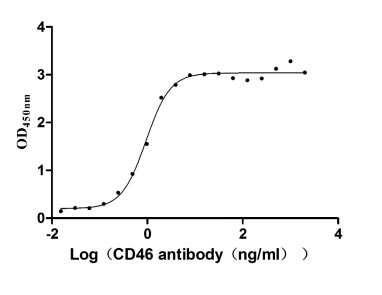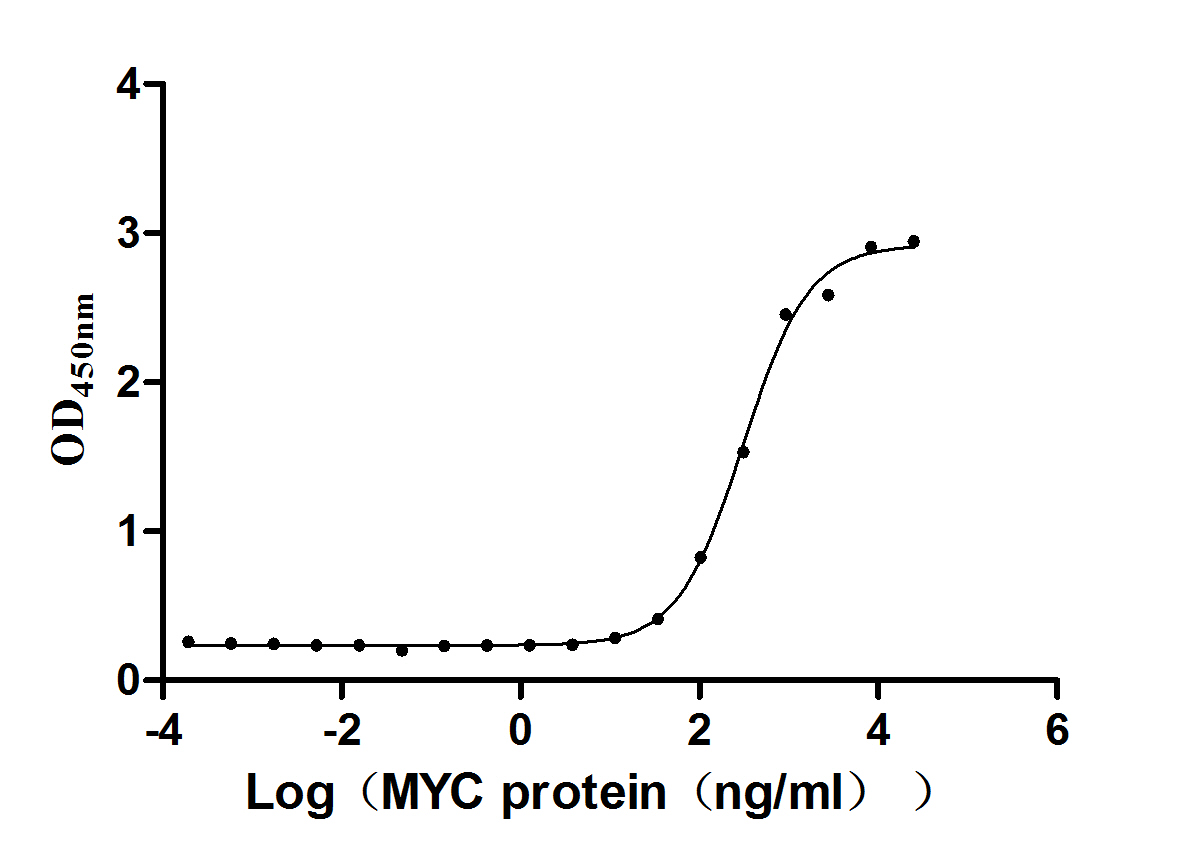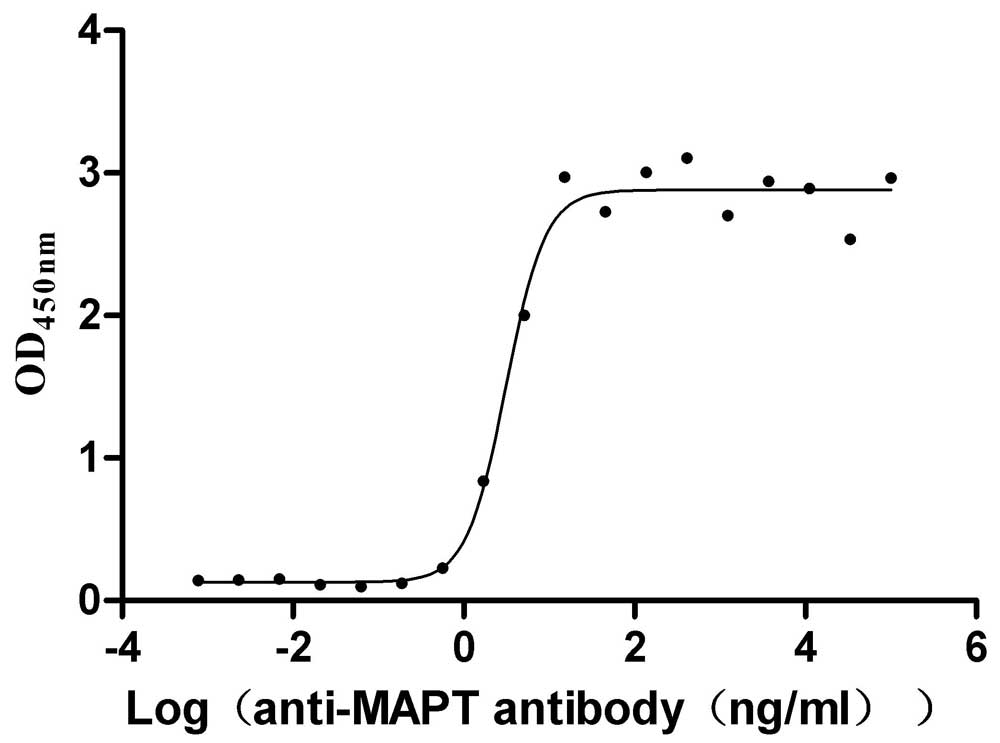Recombinant Human Dyslexia susceptibility 1 candidate gene 1 protein (DYX1C1)
-
中文名称:人DNAAF4重组蛋白
-
货号:CSB-YP855504HU
-
规格:
-
来源:Yeast
-
其他:
-
中文名称:人DNAAF4重组蛋白
-
货号:CSB-EP855504HU
-
规格:
-
来源:E.coli
-
其他:
-
中文名称:人DNAAF4重组蛋白
-
货号:CSB-EP855504HU-B
-
规格:
-
来源:E.coli
-
共轭:Avi-tag Biotinylated
E. coli biotin ligase (BirA) is highly specific in covalently attaching biotin to the 15 amino acid AviTag peptide. This recombinant protein was biotinylated in vivo by AviTag-BirA technology, which method is BriA catalyzes amide linkage between the biotin and the specific lysine of the AviTag.
-
其他:
-
中文名称:人DNAAF4重组蛋白
-
货号:CSB-BP855504HU
-
规格:
-
来源:Baculovirus
-
其他:
-
中文名称:人DNAAF4重组蛋白
-
货号:CSB-MP855504HU
-
规格:
-
来源:Mammalian cell
-
其他:
产品详情
-
纯度:>85% (SDS-PAGE)
-
基因名:DNAAF4
-
Uniprot No.:
-
别名:Dyslexia susceptibility 1 candidate 1; Dyslexia susceptibility 1 candidate gene 1 protein; DYX1; DYX1C1; DYXC1; DYXC1_HUMAN; EKN1; FLJ37882; MGC70618; RD
-
种属:Homo sapiens (Human)
-
蛋白长度:full length protein
-
表达区域:1-420
-
氨基酸序列MPLQVSDYSW QQTKTAVFLS LPLKGVCVRD TDVFCTENYL KVNFPPFLFE AFLYAPIDDE SSKAKIGNDT IVFTLYKKEA AMWETLSVTG VDKEMMQRIR EKSILQAQER AKEATEAKAA AKREDQKYAL SVMMKIEEEE RKKIEDMKEN ERIKATKALE AWKEYQRKAE EQKKIQREEK LCQKEKQIKE ERKKIKYKSL TRNLASRNLA PKGRNSENIF TEKLKEDSIP APRSVGSIKI NFTPRVFPTA LRESQVAEEE EWLHKQAEAR RAMNTDIAEL CDLKEEEKNP EWLKDKGNKL FATENYLAAI NAYNLAIRLN NKMPLLYLNR AACHLKLKNL HKAIEDSSKA LELLMPPVTD NANARMKAHV RRGTAFCQLE LYVEGLQDYE AALKIDPSNK IVQIDAEKIR NVIQGTELKS
-
蛋白标签:Tag type will be determined during the manufacturing process.
The tag type will be determined during production process. If you have specified tag type, please tell us and we will develop the specified tag preferentially. -
产品提供形式:Lyophilized powder
Note: We will preferentially ship the format that we have in stock, however, if you have any special requirement for the format, please remark your requirement when placing the order, we will prepare according to your demand. -
复溶:We recommend that this vial be briefly centrifuged prior to opening to bring the contents to the bottom. Please reconstitute protein in deionized sterile water to a concentration of 0.1-1.0 mg/mL.We recommend to add 5-50% of glycerol (final concentration) and aliquot for long-term storage at -20℃/-80℃. Our default final concentration of glycerol is 50%. Customers could use it as reference.
-
储存条件:Store at -20°C/-80°C upon receipt, aliquoting is necessary for mutiple use. Avoid repeated freeze-thaw cycles.
-
保质期:The shelf life is related to many factors, storage state, buffer ingredients, storage temperature and the stability of the protein itself.
Generally, the shelf life of liquid form is 6 months at -20°C/-80°C. The shelf life of lyophilized form is 12 months at -20°C/-80°C. -
货期:Delivery time may differ from different purchasing way or location, please kindly consult your local distributors for specific delivery time.Note: All of our proteins are default shipped with normal blue ice packs, if you request to ship with dry ice, please communicate with us in advance and extra fees will be charged.
-
注意事项:Repeated freezing and thawing is not recommended. Store working aliquots at 4°C for up to one week.
-
Datasheet :Please contact us to get it.
相关产品
靶点详情
-
功能:Axonemal dynein assembly factor required for ciliary motility. Involved in neuronal migration during development of the cerebral neocortex. May regulate the stability and proteasomal degradation of the estrogen receptors that play an important role in neuronal differentiation, survival and plasticity.
-
基因功能参考文献:
- that endogenous DYX1C1 localizes to the base of the cilium, whereas DCDC2 localizes along the entire axoneme of the cilium PMID: 27451412
- promoter SNP rs12899331 of DYX1C1 may contribute towards the manifestation of DD. This study supports the association of DYX1C1 with DD in an Indian population PMID: 24362368
- results demonstrate that DYX1C1 can modulate the expression of genes involved in cell migration and nervous system development and associates with a number of cytoskeletal proteins. PMID: 23036959
- DYX1C1 is required for axonemal dynein assembly and ciliary motility. PMID: 23872636
- The results of this study do not provide evidence for association between the putatively functional single nucleotide polymorphisms -3G/A and 1249G/T in DYX1C1 and reading disabilities. PMID: 23341075
- Gene-by-environment effects were found between some specified environmental moderators (i.e. maternal smoke during pregnancy, birth weight and socio-economic status) and the DYX1C1-1259C/G marker PMID: 23176554
- results suggested that the 931C > T variant in KIAA0319, but not the -3G > A in DYX1C1, was significantly associated with the risk of dyslexia PMID: 23065966
- DYX1C1 influences reading development in the general Chinese population and supports a universal effect of this gene. PMID: 23028439
- The results of this study found that DYX1C1 gene contained polymorphisms that were significantly associated with white matter volume in the left temporo-parietal region and that white matter volume influenced reading ability. PMID: 22683091
- Mutations in cilia co-expressed DCDC2, DYX1C1 and KIAA0319 genes are associated with a cognitive neurological disorder, dyslexia. PMID: 22558177
- the expression of DYX1C1 in breast cancer is associated with several clinicopathological parameters and that loss of DYX1C1 correlates with a more aggressive disease, in turn indicating that DYX1C1 is a potential prognostic biomarker in breast cancer. PMID: 22375924
- A single nucleotide polymorphism previously shown to be associated with dyslexia and located in the cis-regulatory region of DYX1C1 may alter the epigenetic and endocrine regulation of this gene. PMID: 22383464
- findings suggest that DYX1C1 is associated with dyslexia in people of Chinese ethnicity. PMID: 21599957
- No statistically significant associations were found between DCDC2 or DYX1C1 and language phenotypes. Both DCDC2 and DYX1C1 DD susceptibility genes appear to have a pleiotropic role on mathematics but not language phenotypes. PMID: 21046216
- At this point, there is no statistical evidence of association between the allelic variation in the three candidate genes and DD in our sample. PMID: 21203818
- Association signals were detected for several single nucleotide polymorphisms within DYX1C1 with both the reading and spelling tests PMID: 20846247
- Results suggest that DYX1C1 influences reading and spelling ability with additional effects on short-term information storage or rehearsal. Missense mutation rs17819126 is a potential functional basis for the association of DYX1C1 with dyslexia. PMID: 19901951
- Functional characterization of the homologous rat protein. PMID: 16989952
- DYX1C1 should be regarded as a candidate gene for developmental dyslexia and localizes to a fraction of cortical neurons and white matter glial cells PMID: 12954984
- Findings provide support for EKN1 as a risk locus for dyslexia and as contributing to reading component processes and reading-related abilities. PMID: 15249932
- Thus it seems unlikely that DYX1C1 gene would be involved in the genetic etiology of autism in Finnish patients. PMID: 15470369
- DYX1C1 is unlikely to be a susceptibility gene for developmental dyslexia PMID: 15477871
- Single nucleotide polymorphisms of DYX1C1 are not associated with dyslexia susceptibility in a large sample of sibling pairs. PMID: 15520411
- disequilibrium with DYX1C1 is more saliently explained in Italian dyslexics by short-term memory PMID: 17309662
- The observation of weak evidence for transmission disequilibrium for one of the two studied polymorphisms in DYX1C1 suggests involvement of this gene in dyslexia. PMID: 17450541
- TFII-I, PARP1, and SFPQ proteins, each previously implicated in gene regulation, form a complex controlling transcription of DYX1C1. Allelic differences in the promoter or 5'UTR of DYX1C1 may affect factor binding and thus regulation of the gene. PMID: 18445785
- Alternatively spliced transcript variants of the DYX1C1 gene may be used as cancer biomarkers to detect colorectal cancer. PMID: 18618141
- The contribution of DYX1C1 to dyslexia in a sample of 366 trios of German descent, was investigated. PMID: 19240663
- The DYX1C1 is a novel Hsp70 and Hsp90-interacting co-chaperone protein and its expression is associated with malignancy. PMID: 19277710
- DYX1C1 interacts with both ERs in the presence of 17beta-estradiol in neurons. PMID: 19423554
显示更多
收起更多
-
相关疾病:Dyslexia 1 (DYX1); Ciliary dyskinesia, primary, 25 (CILD25)
-
亚细胞定位:Nucleus. Cytoplasm. Dynein axonemal particle. Cell projection, neuron projection.
-
组织特异性:Expressed in several tissues, including brain, lung, kidney and testis. In brain localizes to a fraction of cortical neurons and white matter glial cells.
-
数据库链接:
HGNC: 21493
OMIM: 127700
KEGG: hsa:161582
STRING: 9606.ENSP00000323275
UniGene: Hs.126403
Most popular with customers
-
Recombinant Human Membrane cofactor protein (CD46), partial (Active)
Express system: Mammalian cell
Species: Homo sapiens (Human)
-
Recombinant Human papillomavirus type 16 Protein E7 (E7) (Active)
Express system: E.coli
Species: Human papillomavirus type 16
-
Recombinant Macaca mulatta Microtubule-associated protein tau (MAPT) (Active)
Express system: Mammalian cell
Species: Macaca mulatta (Rhesus macaque)
-
Recombinant Macaca mulatta Semaphorin-4D isoform 1 (SEMA4D), partial (Active)
Express system: Mammalian cell
Species: Macaca mulatta (Rhesus macaque)
-
Recombinant Human Desmoglein-3 (DSG3), partial (Active)
Express system: Baculovirus
Species: Homo sapiens (Human)
-
Recombinant Rat Gastric inhibitory polypeptide receptor (Gipr), partial (Active)
Express system: Mammalian cell
Species: Rattus norvegicus (Rat)
-
Express system: Mammalian cell
Species: Macaca mulatta (Rhesus macaque)
-
Express system: Mammalian cell
Species: Homo sapiens (Human)




















